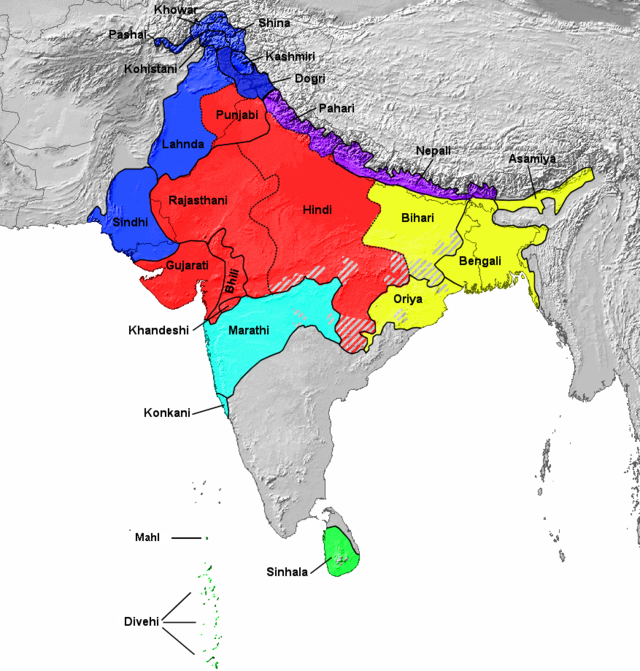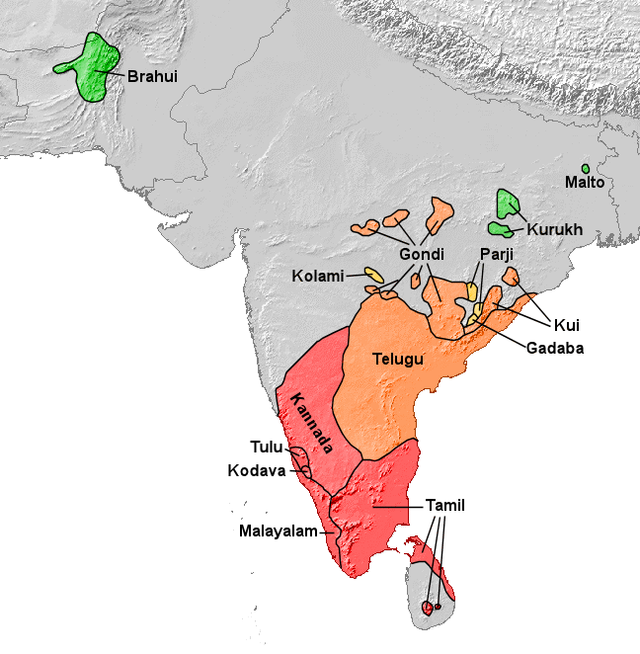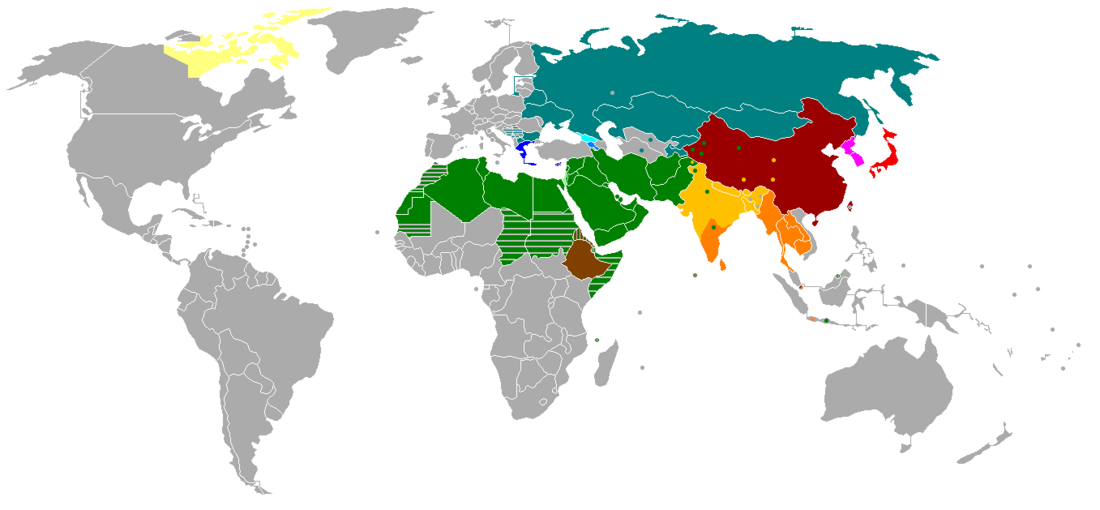බ්රාහ්මීය අක්ෂර පවුල
අබුගිඩා ලේඛන ක්රම කුටුම්භය From Wikipedia, the free encyclopedia
Remove ads
බ්රාහ්මීය අක්ෂර මාලා යනුවෙන් හඳුන්වන්නේ අබුගිඩා ලේඛන ක්රම කුටුම්භයකි. මේවා ඉන්දියානු උපමහාද්වීපය, අග්නිදිග ආසියාව සහ සිද්ධං අක්ෂර ස්වරූපයෙන් ජපානය ඇතුළු නැගෙනහිර ආසියාව යන ප්රදේශවල භාවිතා වේ. පුරාතන ඉන්දියාවේ බ්රාහ්මී හෝඩියෙන් සම්භවය වූ මෙම අක්ෂර මාලාවන් දකුණු, නැගෙනහිර සහ අග්නිදිග ආසියාවේ විවිධ භාෂා පවුල් තුළ භාවිතා වේ: ඉන්දු-ආර්ය, ද්රවිඩ, ටිබෙට්-බුරුම, මොංගෝලික, ඕස්ට්රෝආසියාතික, ඕස්ට්රෝනීසියානු සහ තායි භාෂා පවුල් තුළ මෙම අක්ෂර භාවිතා වේ.
Remove ads
History
Brahmic scripts descended from the Brahmi script. Brahmi is clearly attested from the 3rd century BC during the reign of Ashoka, who used the script for imperial edicts, but there are some claims of earlier epigraphy found on pottery in South India and Sri Lanka. The most reliable of these were short Brahmi inscriptions dated to the 4th century BC and published by Coningham et al. (1996).[2] Northern Brahmi gave rise to the Gupta script during the Gupta period, which in turn diversified into a number of cursives during the medieval period. Notable examples of such medieval scripts, developed by the 7th or 8th century, include Nagari, Siddham and Sharada.
The Siddhaṃ script was especially important in Buddhism, as many sutras were written in it. The art of Siddham calligraphy survives today in Japan. The syllabic nature and dictionary order of the modern kana system of Japanese writing is believed to be descended from the Indic scripts, most likely through the spread of Buddhism.[3]
Southern Brahmi evolved into the Old Kannada, Pallava and Vatteluttu scripts, which in turn diversified into other scripts of South India and Southeast Asia.
The present Telugu script is derived from the Kannada-Telugu script, also known as "Old Kannada script", owing to its similarity to the same.[4]
- A fragment of Ashoka's 6th pillar edict, in Brahmi, the ancestor of all Brahmic scripts
- Spread of Brahmic family of scripts from India
Remove ads
Characteristics
Some characteristics, which are present in most but not all the scripts, are:
- Each consonant has an inherent vowel which is usually a short 'a' (in Bengali, Assamese and Odia, the phonetic is 'ɔ' due to sound shifts). Other vowels are written by adding to the character. A mark, known in Sanskrit as a virama/halant, can be used to indicate the absence of an inherent vowel.
- Each vowel has two forms, an independent form when not attached to a consonant, and a dependent form, when attached to a consonant. Depending on the script, the dependent forms can be either placed to the left of, to the right of, above, below, or on both the left and the right sides of the base consonant.
- Consonants (up to 4 in Devanagari) can be combined in ligatures. Special marks are added to denote the combination of 'r' with another consonant.
- Nasalization and aspiration of a consonant's dependent vowel is also noted by separate signs.
- The alphabetical order is: vowels, velar consonants, palatal consonants, retroflex consonants, dental consonants, bilabial consonants, approximants, sibilants, and other consonants. Each consonant grouping had four stops (with all four possible values of voicing and aspiration), and a nasal consonant.
Remove ads
සංසන්දනය
පහත සැසඳුම් වගුවෙහි දැක්වෙන්නේ ප්රධාන භාරතීය අක්ෂර මාලාවන් කිහිපයක් වන අතර, එකම බ්රාහ්මී අක්ෂර සමූහයකින් ඒවා සම්භවය වී ඇති බව පෙන්වීමට මෙමඟින් උත්සහ දරා ඇත. මේ අනුව:
- The charts are not comprehensive. Glyphs may be unrepresented if they don't derive from any Brahmi character, but are later inventions.
- සෑම පේළියකම වූ අක්ෂරවල උච්චාරණයන් සමාන නොවිය හැක. උච්චාරණය සහිත පේළිය pronunciations of glyphs in the same column may not be identical. The pronunciation row is only representative; the International Phonetic Alphabet (IPA) pronunciation is given for Sanskrit where possible, or another language if necessary.
The transliteration is indicated in ISO 15919.
ව්යඤ්ජන
- Notes
- This list (tries to) includes characters of same origins, not same sounds. In Bengali র is pronounced as rô but it is originally va which is still used for wa sound in Mithilakshar and modern Assamese ৱ (wabbô) was derived from middle Assamese র (wô). Compare with জ (ja) য (ya) and য় (ẏ) which are pronounced as jô, jô and yô in Bengali and zô, zô and yô in Assamese respectively. য is related to Devanagari य (ya) and it is still pronounced as "ya" in Mithilakshar. Since their sounds shifted, the dots were added to keep the original sounds.
ස්වර
මෙහි ස්වර වම්පස පේළියෙහි එහි ස්වාධීන ස්වරූපයෙන් ද, දකුණු පසින් ඒවායෙහි පිල්ලම් ස්වරූපයෙන් ක් ව්යඤ්ජනාක්ෂරය සමග සම්බන්ධ කොට ද දක්වා ඇත. A glyph for ka is an independent consonant letter itself without any vowel sign, where the vowel a is inherent.
- සටහන්
සංඛ්යා
- Notes
Remove ads
බ්රාහ්මීය අක්ෂර මාලා ලැයිස්තුව
ඓතිහාසික


ක්රි.පූ. 3වන සියවස පමණ හමුවන ආදිතම අභිලේඛන අනුව, බ්රාහ්මී අක්ෂර මාලාවෙහි ප්රාදේශීය වෙනස්කම් පැවති බැව් පෙනේ. ක්රි.ව. 5වන සියවස පමණ වන විට්, බ්රාහ්මී අක්ෂර මාලාව තවදුරටත් වෙනස්කම්වලට භාජනය වී මධ්යකාලීන යුගය වන විට නව අක්ෂර මාලාවන් රැසක් බවට විකසනය විය. අතීත අක්ෂර මාලාවන් ප්රධාන වශයෙන්ම උත්තර සහ දක්ෂිණ බ්රාහ්මී අක්ෂර මාලාවන් ලෙස බෙදා දැක්වේ. උත්තර කාණ්ඩයේ ගුප්ත අක්ෂර මාලාව බෙහෙවින් බලපැවැත්වුණු අතර, දක්ෂිණ සමූහයෙහි භාවිතා වූ වට්ටේලුට්ටු සහ පැරණි-කන්නඩ/පල්ලව අක්ෂර බුද්ධාගමේ ව්යාප්තියත් සමඟින් අග්නිදිග ආසියාව කරා ද ව්යාප්ත විය.
උත්තර බ්රාහ්මීය
- ගුප්ත, 4වන සියවස
- ශාරදා
- ලණ්ඩා
- ගුර්මුඛී
- ඛෝජ්කී
- Khudabadi
- මහාජනී
- මුල්තානී
- Takri
- Dogri
- ලණ්ඩා
- සිද්ධං
- නාගරී
- දේවනාගරී
- මෝඩී
- ගුජරාටි
- නන්දිනාගරී
- කේථී
- Sylheti Nagari
- Gaudi
- බෙංගාලි–ඇසෑමි (නැගෙනහිර නාගරී)
- අසෑමි
- Bengali
- Tirhuta (Mithilakshar)
- Odia
- බෙංගාලි–ඇසෑමි (නැගෙනහිර නාගරී)
- Meetei Mayek
- Nepalese
- Bhujimol
- Ranjana
- Soyombo
- Pracalit
- නාගරී
- Tibetan
- Lepcha
- Limbu
- 'Phags-pa
- Zanabazar square
- Marchen
- Marchung
- Pungs-chen
- Pungs-chung
- Drusha
- Lepcha
- Bhaiksuki
- ශාරදා
- Kalinga
- Tocharian (Slanting Brahmi)
දක්ෂිණ බ්රාහ්මීය
- දෙමළ-බ්රාහ්මී, ක්රි.පූ. 2වන සියවස
- පල්ලව
- දෙමළ
- ග්රන්ථ
- මලයාලම්
- Tigalari
- දිවෙස් අකුරු
- සෞරාෂ්ට්ර
- ඛමේර්
- Khom Thai
- සුඛෝතායි
- තායි
- Tai Viet
- Dai Don
- Fakkham
- Tai Yo
- Thai Noi
- Lao
- තායි
- Cham
- කවි
- බාලි
- Batak
- ජාවා
- සුන්ඩා
- Lontara
- Makasar
- Lampung
- Rencong
- Rejang
- Baybayin
- Buhid
- Hanunó'o
- Tagbanwa
- Kulitan
- Old Mon
- Vatteluttu
- Kolezhuthu
- Malayanma
- පල්ලව
- සිංහල
- Bhattiprolu
- කාදම්බා
- තෙලිඟු-කන්නඩ
- කන්නඩ
- Goykanadi
- තෙලිඟු
- කන්නඩ
- Pyu
- බුරුම්
- Ahom
- චක්මා
- S'gaw Karen
- Shan
- Lik-Tai
- Mon
- Tai Le
- Tai Tham
- Lao Tham
- New Tai Lue
- බුරුම්
- තෙලිඟු-කන්නඩ
- කාදම්බා
යුනිකෝඩ්
යුනිකෝඩ් ප්රභේද 13.0 අනුව, පහත බ්රාහ්මී අක්ෂර මාලා කේතනය කොට ඇත:
Remove ads
See also
- Devanagari transliteration
- International Alphabet of Sanskrit Transliteration
- National Library at Kolkata romanization
- Bharati Braille, the unified braille assignments of Indian languages
- Indus script – the earliest writing system on the Indian subcontinent
- ISCII – the coding scheme specifically designed to represent Indic scripts
References
External links
Wikiwand - on
Seamless Wikipedia browsing. On steroids.
Remove ads


